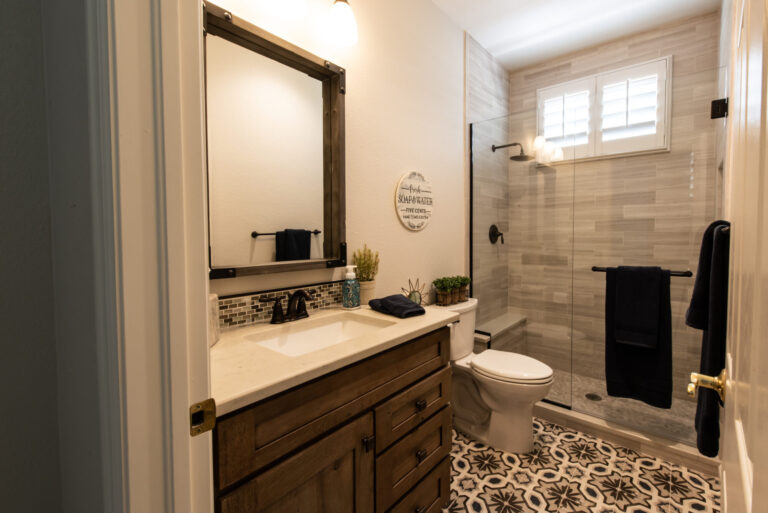On this page
Custom bathroom remodel projects can feel overwhelming at first, especially if you work long hours and don’t live in the world of construction. This guide is written in plain language for blue-collar homeowners who want straight answers and a clear process. Elite Cabinetry & Granite has remodeled hundreds of bathrooms in the Denver area, and our goal here is to teach you the steps, set real expectations, and help you make choices that fit your home, your schedule, and your budget. You’ll learn how to plan, how the timeline works, which materials make sense, what to expect during demolition and install, and how to care for your new space.

1. Why a Custom Bathroom Remodel Delivers Real Value
A bathroom is the most used private space in a home. When the layout is awkward or fixtures are worn out, daily routines get slower and more frustrating. A custom remodel solves root problems rather than hiding them with quick swaps. You can change the layout, improve storage, upgrade ventilation, and install reliable water-saving fixtures. You also get a surface package that stands up to moisture, hard water, and heavy use—making mornings easier and cleaning faster.
Why custom beats a basic swap
A basic project swaps old for new in the same spots. A custom bath lets you re-think the space: convert a tub to a walk-in shower, move the toilet for privacy, add a second sink, build a linen tower, or widen the doorway for safer access. These changes take planning—but they pay off every day.
Where value shows up
Buyers look for clean tile work, sturdy cabinets, bright lighting, and a watertight shower system. Those items signal quality and reduce risk. Daily life improves too: hot water arrives faster, storage actually fits your gear, and the floor stays dry because the shower glass and pan are sealed the right way.
2. Planning Your Project Like a Pro
Clear planning prevents blown budgets and delays. List your must-haves and nice-to-haves, set a realistic total budget, choose a target start month, and define your preferred completion window. If you’ll live in the home during work, consider school breaks, holidays, and shift schedules.
Budget & timeline that won’t break
Account for design, demolition, disposal, framing, plumbing, electrical, drywall, paint, waterproofing, tile, glass, cabinets, tops, fixtures, mirrors, and hardware. Add a 10–15% contingency for hidden damage. A standard hall bath typically runs 3–5 weeks depending on tile complexity and glass lead time; large primary suites take longer.
Typical cost spread (high-level)
- Cabinetry & countertops: ~25%
- Tile & flooring: ~20%
- Plumbing fixtures & drains: ~20%
- Glass, lighting, paint, accessories: ~15%
- Labor, design, project management: remainder
Design for function & flow
Think in routines. Where do towels live when they’re clean—and where do they go when wet? Do you shave in the shower or at the sink? Do you share the mirror in the morning? Plan outlets for hair tools and razors. Use task lighting at the mirror and softer lighting for nights. Map drawers and shelves so everything has a home.
3. Materials That Work Hard and Look Good
Choose finishes that stand up to water, steam, soap, and scrubbing. When in doubt, simpler lines are easier to keep clean.
Cabinetry & countertops
Plywood boxes and solid face frames handle moisture better than particleboard. Soft-close hinges reduce wear. Quartz is popular for being non-porous and consistent; granite also performs well when sealed on schedule. Eased or small-radius edges are fast to wipe down and don’t catch debris.

Tile, flooring & waterproofing
Porcelain tile is dense and durable. Large-format reduces grout lines; textured finishes add traction. Under the tile, use a complete waterproofing system from pan to walls. Heated floors connect to a dedicated circuit and thermostat for comfort.
Grout that lasts
Light grout blends and makes spaces feel larger; dark grout hides soil. Pre-mixed or epoxy grouts cost more but resist stains. Seal as directed.
Countertop edges
Eased and quarter-round edges are comfortable and easy to clean. Ogee and double-rolled bring a traditional look. Review edge samples against your cabinet doors and drawer fronts.
4. The Step-by-Step Timeline
Exact schedules depend on lead times and inspections, but the sequence below holds for most projects.
- Showroom consultation & design — Review door styles, finishes, hardware, tops, tile, and glass. We document habits and build a plan with drawings and scope.
- Site measure & final proposal — Verify dimensions, vent paths, and code items. Confirm door swings, vanity height, shower size, and niche locations.
- Permits, ordering & staging — Pull permits as required; order long-lead items; stage materials so demo doesn’t start until key parts are on-site.
- Demolition, rough work & waterproofing — Protect floors; remove old finishes; set valves, drains, boxes, fans, and circuits; close walls and complete waterproofing.
- Tile, cabinets, tops, fixtures & glass — Set pans, walls, floors; level and anchor cabinetry; template and fabricate tops; set fixtures; measure glass after tile cures.
Handling surprises the right way: older homes can hide slow leaks, failed pans, or ungrounded wiring. If something appears, we explain options and price the fix before work continues.
Final walkthrough & turnover: we test valves, confirm fan airflow, check drainage, and complete punch items. You receive care instructions and warranty details.
5. Caring for Your New Bathroom
Use gentle cleaners, keep good airflow, and fix drips quickly. The right habits help surfaces last and keep caulk and grout looking clean.
Protecting stone, quartz & metal
Use pH-neutral cleaners on stone and quartz; avoid harsh acids and abrasive pads. Dry water spots on dark and stainless fixtures to prevent mineral marks. Reseal natural stone on the recommended schedule.
Low-effort tile & grout care
- Run the fan during showers and for 20 minutes after.
- Squeegee glass and walls daily to reduce soap buildup.
- Clean grout weekly with a soft brush and mild soap.
- Spot-seal splash zones annually.
Ready to Start Your Custom Bathroom Remodel?
Visit the Elite Cabinetry & Granite showroom to see door styles, countertops, and tile options in person. Bring photos and simple measurements, and our team will create a design that fits your space and budget. We keep communication clear, protect your home, and deliver a bathroom that works as hard as you do.
Quick Tips for Homeowners
- Label your shutoff valves.
- Snap photos of wall framing before tile.
- Store extra tiles and keep a spare fan motor.
- Write paint codes inside the vanity.
- Test water pressure before remodeling.
- Confirm the water heater supports long showers.
- Use a shower squeegee daily.
- Clean silicone with mild soap.
- Check caulk each spring.
- Vacuum fan grilles and replace any tripping GFCI outlets.


3 Comments
Lorem ipsum dolor sit amet, consectetur adipiscing elit, sed do eiusmod tempor incididunt ut labore et dolore magna aliqua. Quis ipsum suspendisse ultrices gravida. Risus commodo viverra maecenas accumsan lacus vel facilisis.
Cras maximus ultricies volutpat. Praesent ut enim non enim vulputate fringilla.
Cras maximus ultricies volutpat. Praesent ut enim non enim vulputate fringilla.